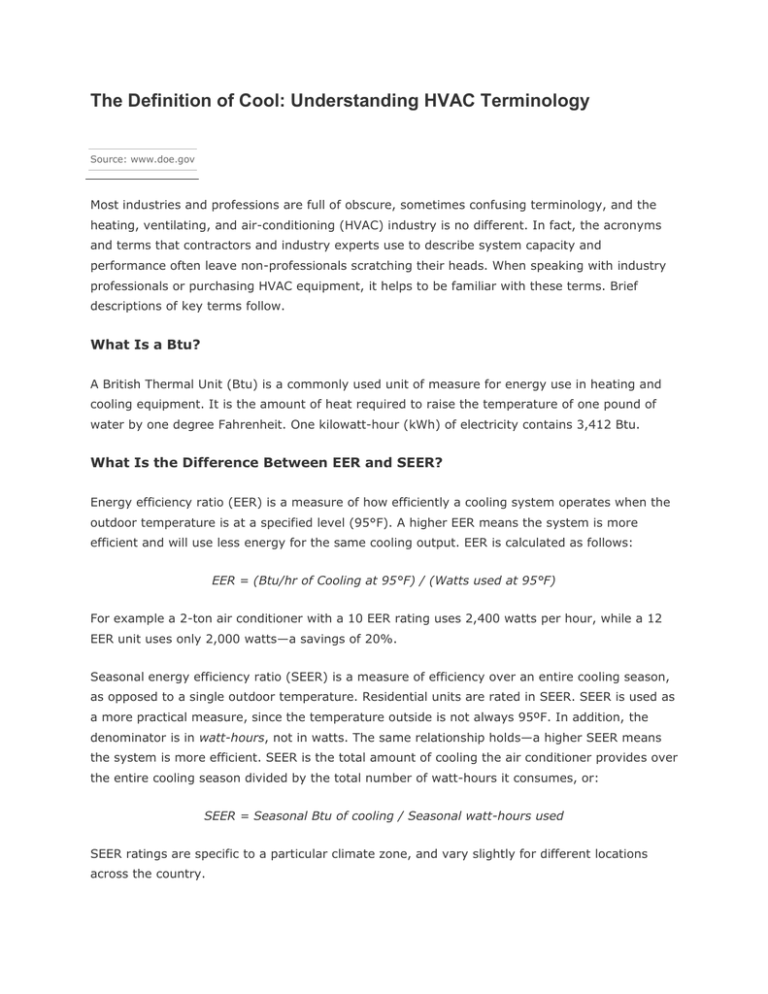The Definition of Cool: Understanding HVAC
advertisement

The Definition of Cool: Understanding HVAC Terminology Source: www.doe.gov Most industries and professions are full of obscure, sometimes confusing terminology, and the heating, ventilating, and air-conditioning (HVAC) industry is no different. In fact, the acronyms and terms that contractors and industry experts use to describe system capacity and performance often leave non-professionals scratching their heads. When speaking with industry professionals or purchasing HVAC equipment, it helps to be familiar with these terms. Brief descriptions of key terms follow. What Is a Btu? A British Thermal Unit (Btu) is a commonly used unit of measure for energy use in heating and cooling equipment. It is the amount of heat required to raise the temperature of one pound of water by one degree Fahrenheit. One kilowatt-hour (kWh) of electricity contains 3,412 Btu. What Is the Difference Between EER and SEER? Energy efficiency ratio (EER) is a measure of how efficiently a cooling system operates when the outdoor temperature is at a specified level (95°F). A higher EER means the system is more efficient and will use less energy for the same cooling output. EER is calculated as follows: EER = (Btu/hr of Cooling at 95°F) / (Watts used at 95°F) For example a 2-ton air conditioner with a 10 EER rating uses 2,400 watts per hour, while a 12 EER unit uses only 2,000 watts—a savings of 20%. Seasonal energy efficiency ratio (SEER) is a measure of efficiency over an entire cooling season, as opposed to a single outdoor temperature. Residential units are rated in SEER. SEER is used as a more practical measure, since the temperature outside is not always 95ºF. In addition, the denominator is in watt-hours, not in watts. The same relationship holds—a higher SEER means the system is more efficient. SEER is the total amount of cooling the air conditioner provides over the entire cooling season divided by the total number of watt-hours it consumes, or: SEER = Seasonal Btu of cooling / Seasonal watt-hours used SEER ratings are specific to a particular climate zone, and vary slightly for different locations across the country. What Is a Ton and What Does it Mean for Air Conditioning? A ton is the cooling capacity of an air conditioning system. One ton is equal to the amount of heat required (288,000 Btu) to melt one ton of ice in a 24-hour period. A one-ton air conditioner is rated at 12,000 Btu per hour (288,000/24). A two-ton unit would be rated at 24,000 Btu per hour. Typical residential central heating systems provide up to 5-tons of cooling. Commercial systems can range anywhere from small, three-ton rooftop units, to 1,500-ton chiller systems. Why a ton of ice? The term is leftover from the days before mechanical cooling when ice was an essential part of refrigeration. What Is COP? Coefficient of performance (COP) ratings are typically found on chiller systems and on gas cooling equipment, as well as on heat pumps. It measures how efficiently a heating or cooling system operates at a single outdoor temperature. A higher COP means higher efficiency. As an example, the commonly used outdoor temperature for a heat pump calculation in the heating mode is 47ºF. The COP for the heat pump would be equal to the Btu of heat produced at 47°F divided by the Btu equivalent of electricity to produce that heat. What Is HSPF? Heating Seasonal Performance Factor (HSPF) is the ratio of the seasonal heating output in Btu divided by the seasonal power consumption in watts for a heat pump. Like SEER ratings for air conditioners, HSPF is a seasonal measure. HSPF ratings of 7 to 9 are common for air source heat pumps, while geothermal (water source) heat pumps typically have HSPF ratings greater than 10. What Is AFUE? Annual fuel utilization efficiency (AFUE) measures the efficiency of heating equipment on a annual basis. AFUE is calculated by dividing the total heat delivered to a conditioned space for a heating season by the total fuel used (in Btu). The higher the AFUE rating, the greater the efficiency. Ratings of 80 to 96 AFUE are typical for natural gas furnaces. What Is Relative Humidity? Relative humidity compares the actual amount of water vapor in the air at a given temperature with the total amount of water vapor the air can hold at that temperature. Warm air has more capacity to hold water vapor than cold air. Relative humidity is stated as a percentage, with a 40% to 60% range common for indoor environments.



